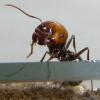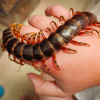I thought I mentioned them on one of my journal or posts before but couldn't find.
But basically, I spoke to one of the popular ant vendors and he said one of the reasons he designed his nest with tight fittings is to not just keep the ants in but also to keep unwanted bugs out. One of the pesky bugs he mentioned were booklice. He said some of the colonies that gradually died out on him (and he keeps MANY, some for 5+++ years) seem to also be infested with booklice. I was like "you sure they weren't springtails?" because I've seen booklice and I never knew that could infest anything in large groups, they seem to be more solitary creatures, wondering around and scavenging on stuff, never in large numbers whenever I see them where I live. He said he was certain. He also said they somehow grown in large numbers in the ant nests, where he can even see them wiggling underneath the mound of brood and whatever is in the ant nests. Even so, he only says he highly SUSPECTS them to be the reason why those nests might have failed, as we all know, there's many reasons why an ant colony can fail. He also said he couldn't find a way to get rid of them completely without also harming the ants.
So I would keep an eye on them.
On a slight off topic: I also found out in the past few years that springtails were also not completely harmless as some people made them out to be. Like how "it's impossible for them to do any harm to a living creature" due to their very weak mouth parts. But I started doubting that when I see how fast they clean up food I drop in or even dead insects. One example are springtails that are often sold as tropical pink springtails (Coecobrya sp. / Sinella curviseta). They've actually killed one of my centipedes and took out sizable chunks on three of my other centipedes after they molted. After I realize it was the springtails (like I had a hunch but was doubting myself because everyone I talked to said it was impossible for them to even be capable of any harm to my animals), I immediately removed them from their container and put them into a nursery container to take care of their wounds, thankfully they all survived and recovered after a molt but it was a close call for one or two of them. While they can't hurt a healthy living creature, if the creature is weakened, have exoskeletons that are still hardening after a molt, or they're leaking fluids like from a wound, the springtails can actually attack those areas and eat around and into it. So wounds that were small and would've healed overtime were opened up and eaten into by these supposedly harmless springtails. Tropical pinks were really good at this because of a few factors: They're slightly larger than average size springtails (bigger size means they are more capable of handling bigger 'jobs', they're extremely quick and mobile (meaning as soon as they sense potential food, they can be all over it real fast), they're very prolific, and they have an appetite for protein (probably with improved mouth parts to handle it too); in order words, it makes them one of the best springtails for cleanup duty.
The point I'm trying to make is, they're both similar size creatures, but beware, they are scavengers and they have abilities to extract food. The species of booklice in with your ants, we don't know what they are. They might indeed be nice and harmless....or....could be like that species of springtails I mentioned, think super soft ant eggs. And some ants are just horrible at dealing with small creatures like that so they got little to no defense.
Also on the side: I have had springtails and grain mites that made it into both my Camponotus and Ectomomyrmex nests, but for some reason or another, they never thrived in there. Happy and glad about that. I think for my Camponotus, it's because they have a bit of that formic acid, maybe.
Edited by BleepingBleepers, July 23 2024 - 8:19 AM.


















